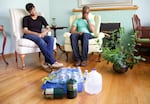
Ed and Sara Johnson sit with what remains of their water and propane supply. They say that over the course of the weekend they learned how to be more efficient with both.
John Rosman / OPB
It was an early Friday evening when both Ed and Sara Johnson got home from work. Since the lights in their Southeast Portland home were off, they fed their cat Baby K by the light of headlamps.
Sitting around their dinner table, they shared the house rules for the weekend.
"No electricity, no running water," said Ed. His wife, Sara, added, "no fridge, no freezer."
Then she remembered something sad. "Oh, the popsicles are in there."
The Johnsons were one of four Oregon families who participated in a weekend of living off their emergency supplies. It was a big experiment for a couple who admit they're not prepared for the megaquake experts say is coming to the Cascadia Subduction Zone off Oregon's coast. But they were good sports — really good sports.
They lived without power, cooked every meal (even the ones for their international student) by propane stove, packed up all their possessions and climbed through a claustrophobic crawl space — all in the name of better informing themselves and their community.
Here are four takeaways from the Johnsons' weekend of surviving the fake quake.
DOING YOUR DISHES IS ANNOYING

The Johnsons use electric lanterns to prepare a meal in the dark at their home in Southeast Portland.
John Rosman / OPB
The first challenge of the weekend came as the Johnsons, who are vegetarians, made a comfort meal of veggie chili over their propane stove.
All the prep dishes were piling up. There were crumbs everywhere. It was dark, and after a full week of work it became too much.
"Look at all these dishes!" said Ed who is usually meticulously clean. "What are we gonna do? We can’t turn on the sink!"
After a life-altering natural disaster, doing dishes seem quaint. But the piled up dishes at the Johnson home represented real challenges in resilience — the biggest being water conservation. Ed and Sara estimated they were using almost a gallon of water a day for food prep, cleaning and washing their hands.
Learn More: Two Sets Of Answers To Many Oregonians' Preparedness Questions
KNOW THE LOCATION OF YOUR GAS SHUTOFF
A pressing issue after an earthquake strikes is the potential for a natural gas leak. According to FEMA, gas leaks are a major cause of fires after a disaster.
Experts say everybody in the home should know where and how to turn off the main gas line.
When OPB asked Ed and Sara to find their gas shutoff, we were taken on an adventure.
After going into a crawl space (pictured), downstairs and finally outside - we found the gas shutoff! #UnpreparedNW pic.twitter.com/4GOz4JDlwx
— John Rosman (@jmrosman) May 16, 2015
They initially thought it was in their crawl space.
"It's crazy down here," said Ed ducking below a pipe and deeper into a space in his home he never imaged going. With his headlamp he pointed to where he thought the shut off might be. Nothing was there.
"The one that’s in the furnace room is the gas shutoff to the house," he said.
It wasn't there either. It was actually outdoors on the side of their home.
It took around a half hour to find the shutoff. But now, if they ever need to they could turn off the gas in a matter of minutes.
Learn more: How To Safely Turn Off Utilities After A Disaster
HAVE A GO-KIT PLANNED

The Johnsons sit outside of their house in Southeast Portland with their cat. One of their main concerns going into the earthquake simulation was whether or not they would have enough cat food in their household.
John Rosman / OPB
The Johnson home was built in 1960. Wood-frame homes built before the mid-1970s are unlikely to be bolted to their foundations — making them more vulnerable to earthquake damage.
The Johnsons didn't think their home is bolted to the foundation either, which means there is a real chance that their home might not be safe shelter after a megaquake.
On Sunday, the couple pretended they had 10 minutes to pack up all of their possessions and leave. In that time, they grabbed warm clothes, headlamps, a whistle, portable bags and good walking shoes.
While those were all useful things to take during an evacuation, Ed and Sara only brought two 16-ounce bottles of water and very little food. They forgot to bring a cat carrier for Baby K, any cash, rain gear or important documents.
Ed also forgot to pack extra underwear.
Learn More: Plan For The Unexpected With An Evacuation Kit
PREPARE EXTRA WATER
"You can never have enough water," said Ed.
By the end of the weekend, the Johnsons only had around 2 gallons of water left. They were surprised by how much water they used.
Here's a fact to put it in perspective: Humans can survive up to three weeks without food, but only a week without water.
Learn more: In case of an emergency there here a few places you can look in your home for more drinkable water.
One of the big takeaways the Johnsons shared from their experience over the weekend is that being prepared is an investment.
"Every month or every pay period, decide on one thing to add to your kit. So that little by little you have more things," said Sara."Instead of looking at [it] like, 'This is so overwhelming. I’m just not going to do anything at all.'"
